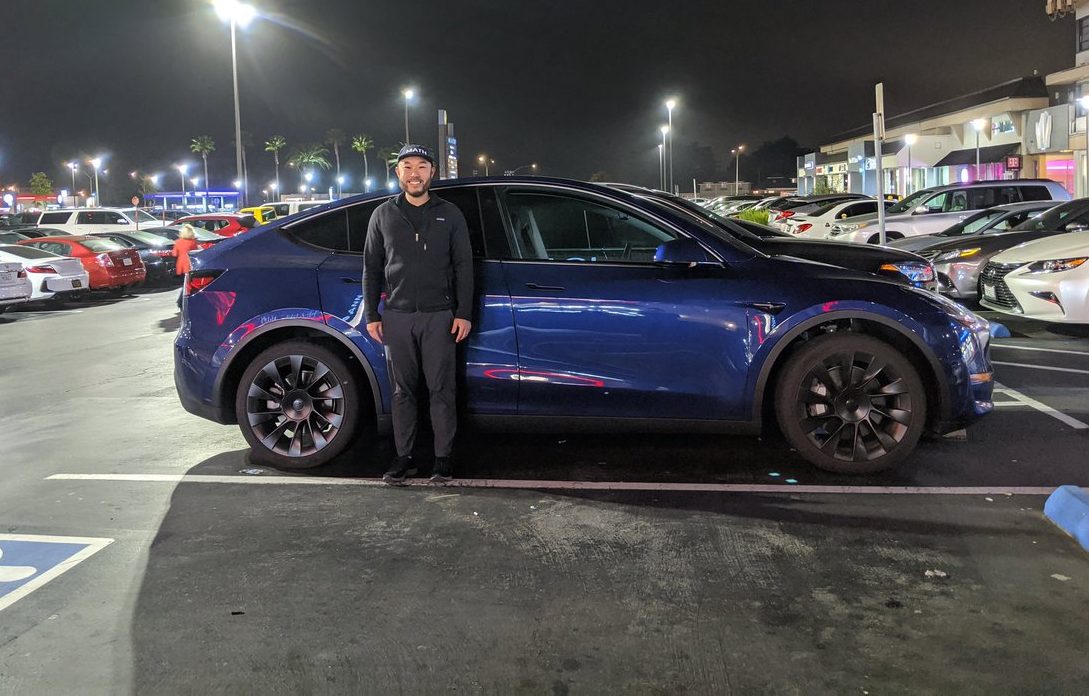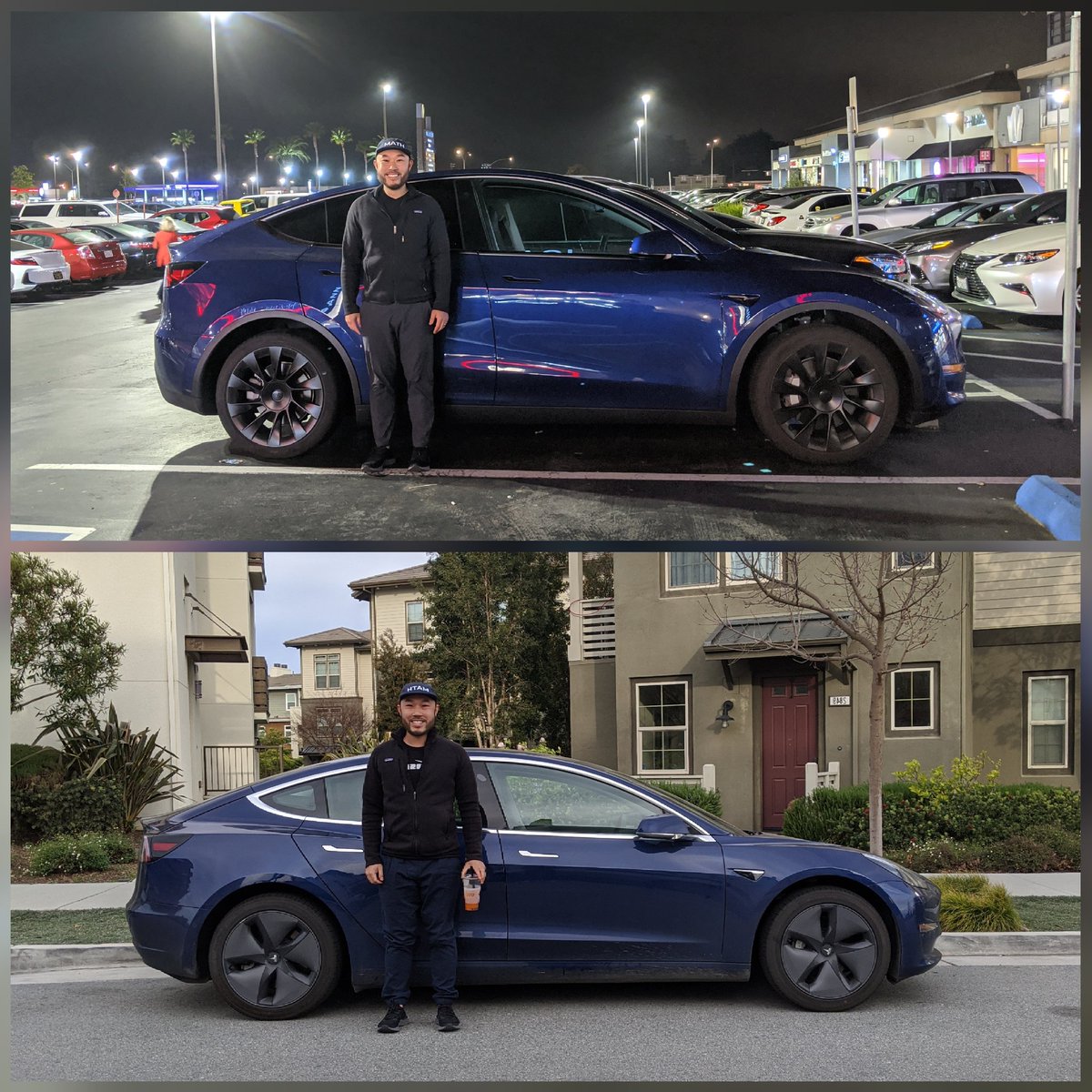

News
Tesla fan’s “selfie” with Model Y vs. Model 3 vs. Model X is the best size comparison yet
A new photo of a Tesla Model Y with a person standing beside it is the best look yet at how the all-electric crossover stacks up in height, and all-around size when compared to the Model 3 sedan and Model X SUV.
Jason Yu snapped a photo of himself standing directly next to a gorgeous Deep Blue Metallic Model Y that he spotted at the Westlake Center in Daly City, California. Standing just over 5 foot 7 inches tall (170 cm) plus an additional .75 inch from the height of his shoes, according to Yu, the Model Y looked closer in size to Tesla’s Model X than its sibling Model 3.
Tesla has not published the dimensions for the Model Y, only noting that it is approximately 10% larger than the Model 3. However, a recent sighting revealed that Model Y has a height of 62.5 inches (158.8 cm). By comparison, Tesla Model 3 has a height of 57 inches (144.8 cm) and appears notably smaller when compared against Yu’s stature.
Yu notes that he was standing 1 inch away from the vehicle and wearing identical shoes in both instances of the photo.

While Yu appears significantly taller than the height of the Model 3, another selfie taken with a Model X tells a different story.
Tesla’s flagship Model X is the company’s largest vehicle to date that’s in production. Standing at 66.3 inches in height (168.4 cm), Model X isn’t much taller than the Model Y with 20″ induction wheels that was captured by Yu. This doesn’t come as much of a surprise, considering both Model X and Model Y are available in a 7-seat configuration with three rows of seating. In both vehicles, the third row of seats can be folded down to create an expansive rear trunk space. A recent sighting of a Model Y reveals a rather large rear cargo space.
Alright, here is a comparison of me standing next to a Model Y vs a Model X. If you want to see me stand next to another vehicle with my yang gang hat, let me know. #ModelY #ModelX #YangGang @Tesla https://t.co/nfQOVjJqaH pic.twitter.com/7NqDxowVKD
— Jayzilla (@jayzilla711) February 29, 2020
Tesla is set to begin first Model Y deliveries to customers as early as March 15. Available in both a Long Range configuration that’s capable of 315 miles per single charge and a 280-mile Performance variant, Tesla’s all-electric crossover is expected to be the company’s biggest seller to date, besting Model 3 in popularity.
The Elon Musk-led electric car company is projecting over 500,000 vehicles delivered in 2020, helped by increasingly better production efficiencies, streamlined vehicle design, and plans to continue Gigafactory deployments across the world.
Tesla #ModelY walkaround video w/ Volvo XC90 comparison provides a great perspective on overall size pic.twitter.com/LNpDOlcmFq https://t.co/Zgk0sY2gyb
— Teslarati Team (@TeslaratiTeam) March 6, 2020

Elon Musk
Elon Musk and Tesla AI Director share insights after empty driver seat Robotaxi rides
The executives’ unoccupied tests hint at the rapid progress of Tesla’s unsupervised Robotaxi efforts.

Tesla CEO Elon Musk and AI Director Ashok Elluswamy celebrated Christmas Eve by sharing personal experiences with Robotaxi vehicles that had no safety monitor or occupant in the driver’s seat. Musk described the system’s “perfect driving” around Austin, while Elluswamy posted video from the back seat, calling it “an amazing experience.”
The executives’ unoccupied tests hint at the rapid progress of Tesla’s unsupervised Robotaxi efforts.
Elon and Ashok’s firsthand Robotaxi insights
Prior to Musk and the Tesla AI Director’s posts, sightings of unmanned Teslas navigating public roads were widely shared on social media. One such vehicle was spotted in Austin, Texas, which Elon Musk acknowleged by stating that “Testing is underway with no occupants in the car.”
Based on his Christmas Eve post, Musk seemed to have tested an unmanned Tesla himself. “A Tesla with no safety monitor in the car and me sitting in the passenger seat took me all around Austin on Sunday with perfect driving,” Musk wrote in his post.
Elluswamy responded with a 2-minute video showing himself in the rear of an unmanned Tesla. The video featured the vehicle’s empty front seats, as well as its smooth handling through real-world traffic. He captioned his video with the words, “It’s an amazing experience!”
Towards Unsupervised operations
During an xAI Hackathon earlier this month, Elon Musk mentioned that Tesla owed be removing Safety Monitors from its Robotaxis in Austin in just three weeks. “Unsupervised is pretty much solved at this point. So there will be Tesla Robotaxis operating in Austin with no one in them. Not even anyone in the passenger seat in about three weeks,” he said. Musk echoed similar estimates at the 2025 Annual Shareholder Meeting and the Q3 2025 earnings call.
Considering the insights that were posted Musk and Elluswamy, it does appear that Tesla is working hard towards operating its Robotaxis with no safety monitors. This is quite impressive considering that the service was launched just earlier this year.
Elon Musk
Starlink passes 9 million active customers just weeks after hitting 8 million
The milestone highlights the accelerating growth of Starlink, which has now been adding over 20,000 new users per day.

SpaceX’s Starlink satellite internet service has continued its rapid global expansion, surpassing 9 million active customers just weeks after crossing the 8 million mark.
The milestone highlights the accelerating growth of Starlink, which has now been adding over 20,000 new users per day.
9 million customers
In a post on X, SpaceX stated that Starlink now serves over 9 million active users across 155 countries, territories, and markets. The company reached 8 million customers in early November, meaning it added roughly 1 million subscribers in under seven weeks, or about 21,275 new users on average per day.
“Starlink is connecting more than 9M active customers with high-speed internet across 155 countries, territories, and many other markets,” Starlink wrote in a post on its official X account. SpaceX President Gwynne Shotwell also celebrated the milestone on X. “A huge thank you to all of our customers and congrats to the Starlink team for such an incredible product,” she wrote.
That growth rate reflects both rising demand for broadband in underserved regions and Starlink’s expanding satellite constellation, which now includes more than 9,000 low-Earth-orbit satellites designed to deliver high-speed, low-latency internet worldwide.
Starlink’s momentum
Starlink’s momentum has been building up. SpaceX reported 4.6 million Starlink customers in December 2024, followed by 7 million by August 2025, and 8 million customers in November. Independent data also suggests Starlink usage is rising sharply, with Cloudflare reporting that global web traffic from Starlink users more than doubled in 2025, as noted in an Insider report.
Starlink’s momentum is increasingly tied to SpaceX’s broader financial outlook. Elon Musk has said the satellite network is “by far” the company’s largest revenue driver, and reports suggest SpaceX may be positioning itself for an initial public offering as soon as next year, with valuations estimated as high as $1.5 trillion. Musk has also suggested in the past that Starlink could have its own IPO in the future.
News
NVIDIA Director of Robotics: Tesla FSD v14 is the first AI to pass the “Physical Turing Test”
After testing FSD v14, Fan stated that his experience with FSD felt magical at first, but it soon started to feel like a routine.

NVIDIA Director of Robotics Jim Fan has praised Tesla’s Full Self-Driving (Supervised) v14 as the first AI to pass what he described as a “Physical Turing Test.”
After testing FSD v14, Fan stated that his experience with FSD felt magical at first, but it soon started to feel like a routine. And just like smartphones today, removing it now would “actively hurt.”
Jim Fan’s hands-on FSD v14 impressions
Fan, a leading researcher in embodied AI who is currently solving Physical AI at NVIDIA and spearheading the company’s Project GR00T initiative, noted that he actually was late to the Tesla game. He was, however, one of the first to try out FSD v14.
“I was very late to own a Tesla but among the earliest to try out FSD v14. It’s perhaps the first time I experience an AI that passes the Physical Turing Test: after a long day at work, you press a button, lay back, and couldn’t tell if a neural net or a human drove you home,” Fan wrote in a post on X.
Fan added: “Despite knowing exactly how robot learning works, I still find it magical watching the steering wheel turn by itself. First it feels surreal, next it becomes routine. Then, like the smartphone, taking it away actively hurts. This is how humanity gets rewired and glued to god-like technologies.”
The Physical Turing Test
The original Turing Test was conceived by Alan Turing in 1950, and it was aimed at determining if a machine could exhibit behavior that is equivalent to or indistinguishable from a human. By focusing on text-based conversations, the original Turing Test set a high bar for natural language processing and machine learning.
This test has been passed by today’s large language models. However, the capability to converse in a humanlike manner is a completely different challenge from performing real-world problem-solving or physical interactions. Thus, Fan introduced the Physical Turing Test, which challenges AI systems to demonstrate intelligence through physical actions.
Based on Fan’s comments, Tesla has demonstrated these intelligent physical actions with FSD v14. Elon Musk agreed with the NVIDIA executive, stating in a post on X that with FSD v14, “you can sense the sentience maturing.” Musk also praised Tesla AI, calling it the best “real-world AI” today.








